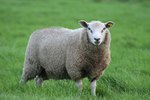Bacterial meningitis is an infection of the membrane surrounding the brain and spinal cord known as the meninges. Lambs 2 to 4 weeks old are most commonly affected but the disease can occur in sheep of any age.
Signs of Infection
Lambs affected by bacterial meningitis may have a wobbly gait with weakness in their rear legs and fail to follow their mothers. Both lambs and sheep affected by meningitis hold their head down with their neck stuck out rigidly and look depressed or lethargic. Adult sheep may drool, walk in circles, stand with their head tilted or stumble around blindly.
Treatment Effectiveness
Treatment for meningitis is effective only if the disease is caught early enough. The bacteria can enter the body through a wound or incision, so call your veterinarian at the earliest signs of infection. Listeriosis, a bacterial disease caused from eating moldy silage, also can cause meningitis. Your farm vet can treat the condition with antibiotic injections twice daily to kill the bacteria and corticosteroids to reduce inflammation. Prognosis for lambs and sheep with meningitis is generally poor once the bacteria reaches the brain. The disease is contagious if another sheep eats pasture or silage contaminated with feces containing the bacteria.
Writer Bio
Indulging her passion for vacation vagary through the written word on a full-time basis since 2010, travel funster Jodi Thornton-O'Connell guides readers to the unexpected, quirky, and awe-inspiring.





